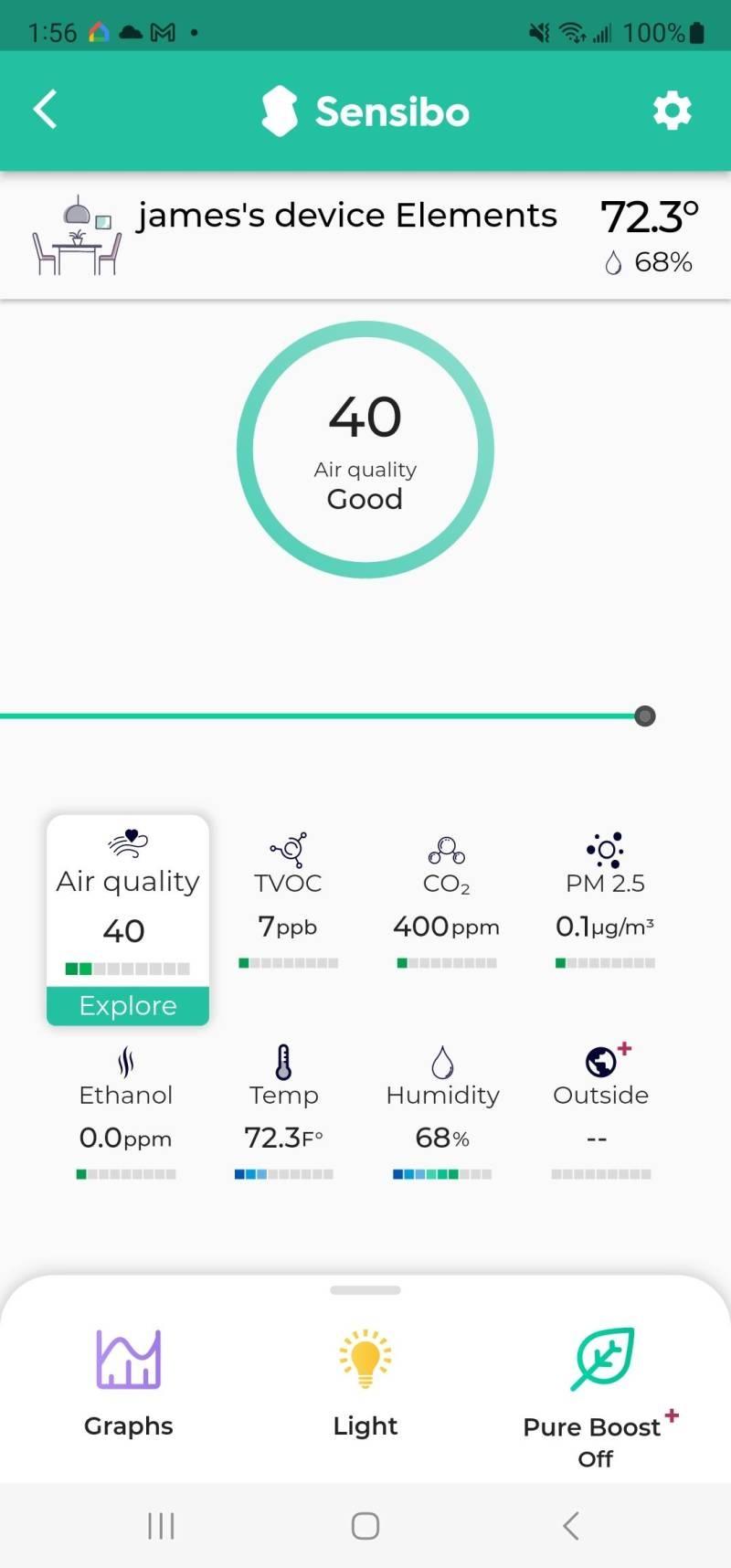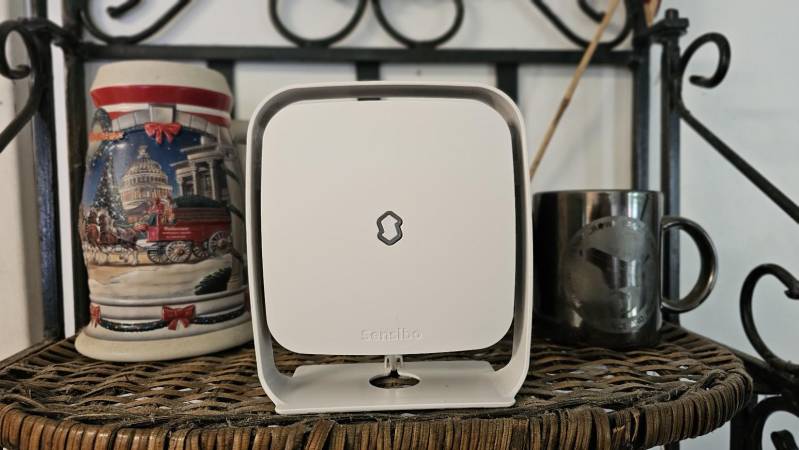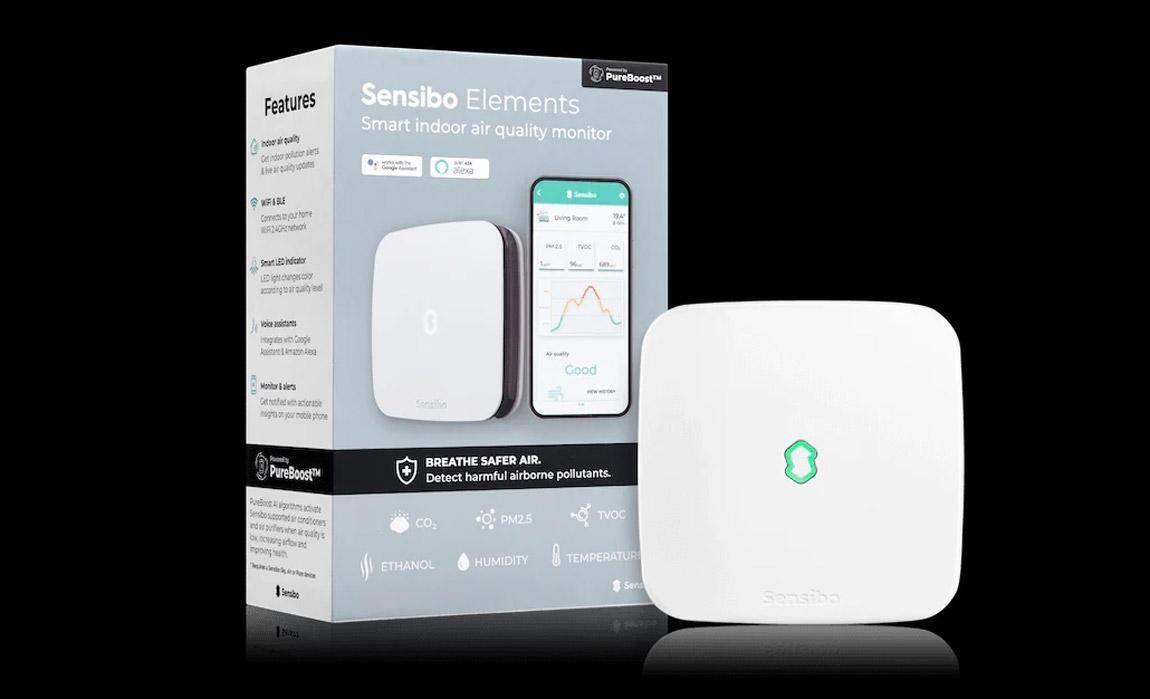For the past decade while living in California, I knew my indoor air quality was bad since we never closed our windows and that meant dust and soot came in ... but was never going to leave. We used everything from duct taping filters to window fans to professional air purifiers to try to pull stuff out of the air where we could. That worked somewhat but I have really no idea how bad the situation actually was or what the ultimate impact of our efforts was ... aside from being "better" based on the particles we collected.
Now that I'm living in a house with a central AC system though I'm actually more concerned since large particles (easily collected by the intake filter on our AC system) are taken care of - but smaller ones that you don't notice are almost certainly in the air. That's why I was excited to test out the Sensibo Elements Indoor Air Quality Monitor that the company sent over.
You might think your home is your safe haven from air pollution, but you could be wrong. Indoor air is often just as, if not more, polluted than the air outside. However, monitoring indoor air quality can seem like a daunting task.
That's where the Sensibo Elements Indoor Air Quality Monitor comes in.
This smart device measures a range of air pollutants, providing real-time and historical data via an app. It tracks PM2.5, volatile organic compounds, carbon dioxide, and ethanol levels, as well as temperature and humidity.
Though it doesn't monitor carbon monoxide or radon, it does link to Sensibo's air purifiers, triggering them when air quality drops. Those two elements are easily tracked though by CO sensors available in most high-quality smoke alarms. Likewise, I'm not concerned about radon since that tends to be a pretty specialized case as well. The nice thing about Sensibo Elements is that it works just as well sitting on my shelf next to me right now in a house as it would in an urban loft. Unlike other products you don't need to connect it to a smart thermostat or even install it somewhere using screws. It simply sits beautifully in a frame on a shelf waiting for me to connect to it via mobile app.
It's a high-tech solution to an often overlooked problem, helping you ensure the air in your home is as healthy as it can be.
So, how bad is the air in your home? Let Sensibo Elements tell you.

Monitoring Indoor Air Quality Is Essential To Good Health
That may seem obvious but despite the fact that we spent as much as 90% of our time indoors, few Americans actually do anything about it! Even worse is that in many homes the concentrations of pollutants can be as much as 2 to 5 times greater than outdoor concentrations.
You think you're breathing clean air in your cozy living room, huh? Well, Sensibo Elements might just burst your bubble with its real-time updates on your indoor air quality, reminding you that those unseen pollutants are having a party in your lungs.
The benefits of monitoring indoor air quality are manifold. It's crucial for your health, as poor indoor air quality can lead to respiratory and cardiovascular diseases. You might not realize it, but common sources of indoor air pollution like dust, pet dander, and mold spores can accumulate and thrive in your home. Even activities like cooking can release harmful particles into the air.
Simple Tips To Help Improve Indoor Air Quality In Your Home
- Proper Ventilation: Ensure your home is well-ventilated. Open windows when the weather permits to allow fresh air to circulate. This will help to dilute any indoor air pollutants. Additionally, using exhaust fans in the kitchen and bathroom can also reduce the level of pollutants indoors.
- Air Purifiers: Consider using air purifiers, especially if someone in your home suffers from allergies or asthma. These devices can help remove contaminants from the air. These can be stand alone units or ones that are integrated into your HVAC system. Be aware though that some purifiers only use ozone or UV light to "sanitize" the air, while others actually rely on filters or collectors that will pull particles from those indoor pollutants out of the air making things truly better to breathe.
- Regular Cleaning: Regular cleaning can reduce dust and pet dander which are common pollutants. Vacuuming regularly, using a vacuum with a HEPA filter, can help reduce allergens. Dusting surfaces and washing bedding frequently can also help.
- Control Humidity: High humidity can increase the presence of mold and dust mites. Keep your home's humidity around 30%-50% to keep these allergens under control. This can be achieved with dehumidifiers and air conditioners.
- Avoid Smoking Indoors: Secondhand smoke can significantly reduce air quality and increase the risk of health issues. Avoid smoking indoors or in enclosed areas.
- Limit Use of Aerosols and VOCs: Many household products like paints, varnishes, wax, and many cleaning, disinfecting, cosmetic, and degreasing products often contain volatile organic compounds (VOCs). These can be harmful when inhaled. Choose products with low or no VOCs when available and always use them as directed with proper ventilation.
- Houseplants: Certain types of houseplants can help purify the air. Spider plants, English ivy, and snake plants, for example, are known for their air-purifying properties. However, remember to care for plants properly to prevent overwatering and potential mold growth.
So, while you're enjoying your favorite show in your living room, remember that unseen threats might be lurking in the air. That's why devices like Sensibo Elements are essential, providing you with actionable insights to improve your indoor air quality.
While it doesn't monitor everything under the sun (or at least under those LED bulbs in your home!), for the first time I truly understood exactly what the indoor environment that I was living in looked like.
About Sensibo Elements Indoor Air Quality Monitor
Sensibo Elements, the indoor air quality monitor, is designed to keep your home environment safe from harmful airborne substances.
What Sensibo Elements Monitors For:
Sensibo Elements monitors six different aspects of indoor air quality and then provides an overall score that tells you the general air quality.
CO2 - Most people "get it" that carbon dioxide can be bad for your health in high concentrations and can lead to fatique, headaches, and lack of focus but most folks don't have any way to monitor it.
Ethanol - Ethanol is one of the most common VOC (Volatile Organic Compounds) found in homes and can come from laundry and dish detergents as well as household cleaners. However, it is also common in decorative and ornamental stoves. While Sensibo Elements doesn't have the sensors to monitor all of the individual VOC's out there, it does measure ethanol specifically and then provides a TVOC count too.
TVOC - This abbreviation stands for Total Volatile Organic Compounds and represents the total volume of the particles in the air from a variety of sources including benzene, ethylene glycol, formaldehyde, methylene chloride and other chemicals commonly found in virtually everything you have in your house from paint thinners to deodorizers, and air fresheners. These compounds can also off-gas from things you wouldn't expect including plastics, glues, paint, disinfectants and cleaners, fabrics, carpets, and laminate floor. Like with PM2.5 particles they can lead to irritation in the eyes, nose, throat as well as headaches and potentially other organs if you are exposed for long periods of time to high concentration levels.
Temperature - Chances are that you already have a temperature monitor on your thermostat but I like the fact that I can check this remotely as well. With that being said, I'm probably going to pick up their Sensibo Air Pro that is a smart thermostat with built-in air quality sensor too. We selected that one as part of top smart home gifts guide. That one works directly with any remote controlled air conditioner or heat pump.
Humidity - High humidity levels above 50% can lead to mold growth, so keeping things below that level indoor can help you maintain a healthy environment.
PM2.5 Particles - these are tiny particles and droplets that are 2.5 microns or less - or about 3% the diameter of a human hair. These particles can be produced by: tobacco smoke, cooking, burning candles, fireplaces, gas and propane heaters, airborne sea salt, dust, pollen, mold spores, and air born pollution from cars as well as industrial facilities. PM2.5 particles are especially important to monitor since unlike some larger sized - PM10 pollutants - PM2.5 can get deeper into lung tissue and cause sneezing, coughing, irritated eyes and other physical reactions that you want to avoid.
Sensibo Elements doesn't just monitor; it helps protect. By tracking the levels of these substances in your home, it alerts you when dust levels rise, potentially indicating higher amounts of PM2.5. With Sensibo Elements, you're not just informed about your indoor air quality; you're empowered to improve it.
Senisobo Elements Can Connect To Their Air Purifier Too
While Sensibo Elements does an excellent job of monitoring your air quality - that's really only one part of the equation. Afterall, what's the point of an air purifier if you don't actually know how bad the problem is or how much better it's gotten since you bought one?
The Sensibo Elements monitor offers wide-ranging integration possibilities with other smart devices, including Sensibo's own air purifier Sensibo PURE.

Your Health And Peace Of Mind Deserves Sensibo
One of the key strengths of the Sensibo Elements monitor is its user-friendly setup and operation. It's designed to be intuitive and easy to use, making it accessible even to those who are new to smart home technology. The monitor provides real-time tracking of air quality data, alerting you instantly when air quality levels drop below the acceptable range. This feature is crucial in addressing poor indoor air quality promptly, as neglecting this issue can lead to various health problems, including allergies and respiratory conditions.
Frankly, what started as a simple "yeah that sounds like an interesting piece of kit to test out" has lead me to consider buying an additional unit along with the PURE for our new condo and leaving this one here in my Father-in-Law's house so he can monitor his air quality too.
While I'm a relatively young guy who is healthy, he has COPD and as you know is currently recovering from pneumonia in the hospital the past few months. Breathing clean air shouldn't be a luxury but it's something that most of us don't think about until we're faced with a situation like he is.
So do yourself a favor and at least consider doing something about improving your indoor air quality!
Sensibo Elements is currently on sale for $119 (normal MSRP $259) and at this price, presents a cost-effective solution for those who value indoor air quality.
